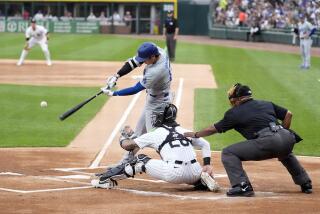Who’s on first? No quick answers in this game : In the Finnish version of baseball, players are all over the place. Now they’re in the U.S., seeking a foothold.
- Share via
HANCOCK, Mich. — There were lots of reasons why Jimmy Piersall was known as a flake back when he played major league baseball, but one of the best came the day he hit a home run as a New York Met and ran the bases backwards.
All of which has little to do with the subject of this story except to illustrate the maxim that what may seem like buffoonery in one setting could make perfect sense in another. Had Piersall been playing in, say, Helsinki rather than Queens, he might have fit right in.
Yes. Baseball has been Finlandized.
The Finns call the game pesapallo and are so crazy about it that it’s considered their national pastime. Of course they do it a little differently. They don’t actually backpedal their way from base to base ala Piersall but, looking at it from a chauvinist American perspective, they do take a backwards route around the basepaths.
First base is where third base ought to be, second is sort of around where first should be and third is somewhere out in left field.
That’s right, Abbott. Who isn’t on first. I Don’t Know is. Sort of.
Anyway, Finnish emigres have spread the game to Scandinavia, Canada and even Australia. And over the weekend they took their first crack at the toughest market of all--the United States, the guarantor of all that is pure and noble about baseball.
Here in Michigan’s rugged Upper Peninsula, the heart of Finnish America, two Canadian pesapallo teams squared off Saturday in a demonstration game before thousands of slightly befuddled spectators at an ethnic festival. In a real slugfest, the Toronto Sisu eked out a 16-15 win over the archrival Thunder Bay Repais.
Organizers of the annual FinnFest say that they hope to field enough domestic talent to stage home-grown pesapallo matches at future gatherings. Already, the Hancock High School baseball coach is talking about teaching the Finnish version to his team.
The main selling point of pesapallo , devotees say, is action. There are no long pauses between pitches, the ball is almost constantly in play and both fielders and runners are forever scampering all over the place.
“In American baseball, a runner on second is in scoring position but in our game he’s just tired,” winked Jari Leinonen, who plays for the Repais. “Usually when we get out there, we pack a lunch.”
The Abner Doubleday of Finland was Lauri Pihkala, a professor who apparently was mesmerized by baseball during early 20th-Century study tours in the United States. He combined the American game with some native ball-playing sports and pesapallo was born.
Both baseball and pesapallo feature four bases, three outs an inning, nine innings, nine players on a side, a hard ball, mitts and a bat--although the Louisville Slugger of Finland is called a Jarvinen Kanuuna . It’s also safe to say that neither game will have Roseanne Barr sing the opening anthem in the future.
That’s where the similarities end. The pesapallo pitcher, for instance, stands next to the plate and tosses the ball up in the air, varying his delivery not with curves or sliders but by the height the ball goes. (Orel Hershiser please note: if the shoulder surgery doesn’t work, a career could still beckon in Finland.)
Instead of waiting in a dugout, teammates of the batter stand around what’s roughly equivalent to the batter’s box and scream out advice whether to swing or not at a pitch. The batter can hit as many as three fair balls before he has to run. And the route around the basepaths sort of zigzags first to the left, then the right, then the left again.
Confused? Try this. A three-base hit is a kunnari , or home run. The batter scores, even though he’s allowed to stay on third and score again if somebody knocks him in. But getting a kunnari is not easy because a ball that’s knocked out of the park--about 300 feet from home to the farthest point of the pesapallo outfield--is considered a laiton (foul).
When an outfielder catches a fly ball, that doesn’t necessarily mean the batter is out. He might just be haava (wounded), a sort of purgatory state for sluggers that requires them to forfeit the turn at bat but doesn’t exactly count toward ending the inning. And when someone does make an out, he’s not just out, he’s pallo (killed). This is no game for wimps, that’s for sure.
There’s one other important difference. At the end of the game, American ballplayers hit the showers. “When we’re done,” said Thunder Bay shortstop Pavli Kaki, “we go off to the sauna.”
More to Read
Go beyond the scoreboard
Get the latest on L.A.'s teams in the daily Sports Report newsletter.
You may occasionally receive promotional content from the Los Angeles Times.










